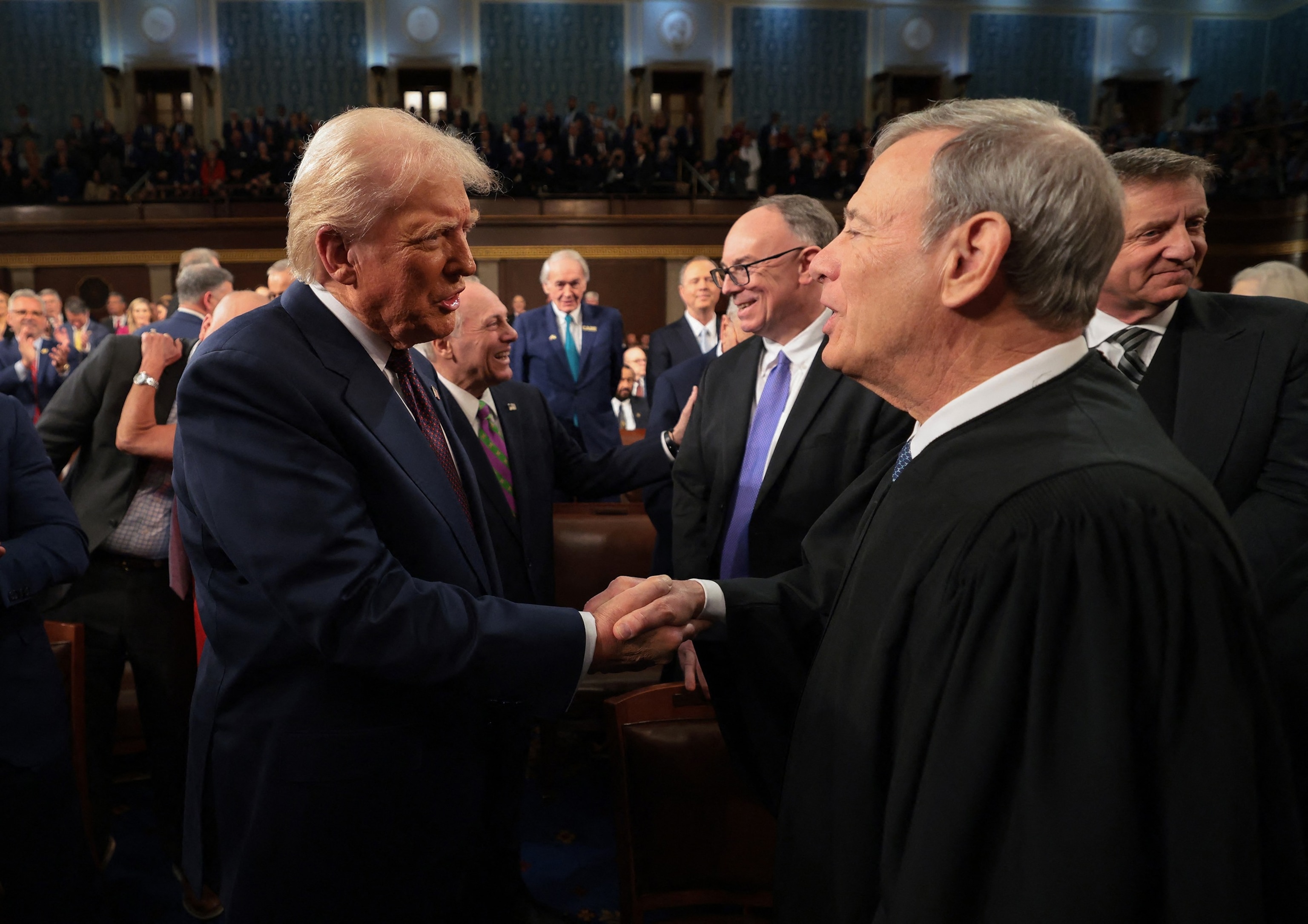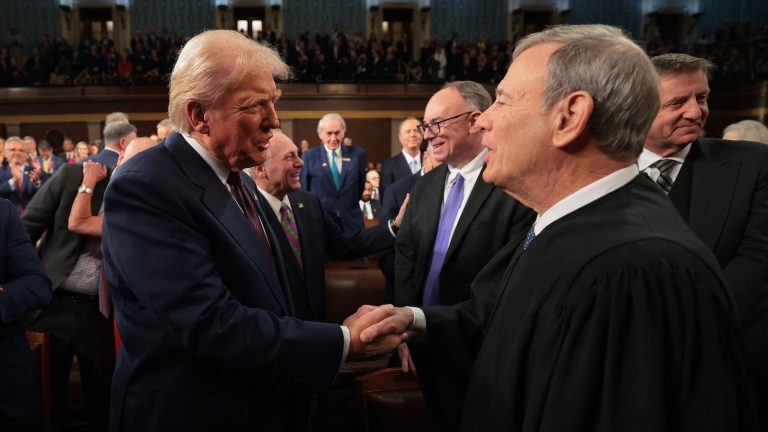As President Donald Trump pushes the limits of executive power, the U.S. Supreme Court has begun to reveal how it will respond to calls to push back, so far doing its best to avoid direct confrontation with the White House while planting a flag over its power of judicial review.
In a series of rulings over the past month on Trump’s emergency requests to override low-level judicial roadblocks, the high court’s conservative majority has been neither a rubber stamp for the president nor an aggressive check on his prerogative.
Instead, it has been a narrowly divided stickler for civil procedure, charting a cautious approach to explosive political disputes. In most cases, it has said very little about the substance of Trump’s actions.
“They are punting as much as they can,” said Sarah Isgur, host of the Advisory Opinions legal podcast and an ABC News Supreme Court analyst.
In effect, the court has given Trump a green light in his quest to aggressively overhauling the federal government, at least for now.

In this Oct. 7, 2022, file photo, United States Supreme Court Associate Justice Sonia Sotomayor, Associate Justice Clarence Thomas, Chief Justice of the United States John Roberts, Associate Justice Samuel Alito, and Associate Justice Elena Kagan, (back row L-R) Associate Justice Amy Coney Barrett, Associate Justice Neil Gorsuch, Associate Justice Brett Kavanaugh and Associate Justice Ketanji Brown Jackson pose for their official portrait at the East Conference Room of the Supreme Court building in Washington, D.C.
Alex Wong/Getty Images, FILE
In three of the four major cases the justices have addressed, a bare majority voted to lift lower court orders temporarily blocking the president’s move to freeze funds, fire workers, or deport immigrants.
All of the cases remain actively litigated and several are expected to return to the court for a more in-depth examination at a later date.
“I think the court, as a whole, is sending a clear signal to the lower courts: stop it. The lower courts should be more careful about entering broad relief where standing is in doubt, and should limit relief to the named parties,” said Josh Blackman, a constitutional law scholar and professor at the South Texas College of Law.
A decision Tuesday by the Supreme Court allowed Trump to move forward with the termination of 16,000 probationary federal workers after a lower court judge had ordered them reinstated. The court ruled that the labor unions behind the case likely lacked standing to bring it.
The Supreme Court also cleared the way for the administration to proceed with the suspension of millions of dollars in federal grants for teacher training after states had urgently asked a judge for the funding to continue. Five justices said the lawsuit was brought in the wrong venue.
On Monday night, the high court lifted a temporary restraining order against Trump’s controversial use of the wartime Alien Enemies Act to rapidly deport alleged Venezuelan gang members. A narrow majority concluded a D.C. federal district court did not have jurisdiction.

Alleged members of the Venezuelan criminal organization Tren de Aragua who were deported by the U.S. government, are detained at the Terrorism Confinement Center in Tecoluca, El Salvador in a photo obtained Mar. 16, 2025.
Secretaria de Prensa de la Presidencia via AFP via Getty Images
In each instance, the court ruled with the slimmest of margins: 5-4. Chief Justice John Roberts and Justice Amy Coney Barrett were decisive figures in forming the majorities.
“Chief Justice Roberts and Justice Barrett seem to flip from case-to-case, but there now is a general five member bloc to reverse the lower courts,” Blackman said.
To some veteran court watchers, the dynamic presents a troubling trend.
“This court majority is not interested in, nor inclined towards, judicially imposed remedies to right legal wrongs,” said Hofstra constitutional law professor James Sample, who noted that the court’s rulings overrode efforts by district court judges to temporarily preserve the status quo and the rights of those most impacted by Trump’s actions.
One uncontested legal wrong remains unaddressed by the Supreme Court: the Trump administration’s mistaken deportation of a man to El Salvador in violation of an immigration ruling that had prohibited his removal to that country because of credible threats to his life.
Chief Justice John Roberts on Monday indefinitely suspended a lower court mandate that the government immediately return him to the U.S. to fix the mistake.
“The [Court’s] majority takes a cavalier and arguably even callous approach to individual rights, especially relative to aggressively asserted executive power,” Sample said.

In this Oct. 21, 2021, file photo, U.S. Supreme Court Associate Justice Amy Coney Barrett and Chief Justice John Roberts pause for photographs at the top of the steps of the west side of the Supreme Court following her investiture ceremony in Washington, D.C. Barrett has been a member of the court for more than a year but her investiture ceremony was delayed because of the coronavirus pandemic.
Chip Somodevilla/Getty Images, FILE
There have been rulings by the court not in Trump’s favor.
In a 5-4 decision last month, a majority of justices said the Trump administration was compelled to pay out $2 billion in foreign aid funds to nonprofit groups for work already completed. The White House had wanted the aid frozen.
In the Alien Enemies Act case, the Court flatly rejected Trump’s argument that deportations under the law are immune from judicial review and also made clear that due process rights must be guaranteed for migrants.
“The administration is claiming victory because they got the case dismissed on venue and now all these detainees have to file habeas petitions,” said Isgur. “But the administration lost 9-0 on the due process question.”
Isgur said the ruling conclusively requires the administration to provide all immigrants the right to challenge their detention and removal, and potentially makes the Alien Enemies Act a more cumbersome and time-consuming legal avenue to pursue.
“It’s a very clever move by the chief justice,” Isgur said. “He’s basically saying: you can either be in Article 3 courts with all of the process rights that are required, including appointed counsel and everything else. Or, you can continue doing this under the Immigration and Nationality Act in immigration court.”
Some of the biggest tests for the Supreme Court — with its six-justice conservative majority, including three justices nominated by Trump in his first term — still lie ahead.

President Donald Trump greets Chief Justice of the United States John Roberts as he arrives to speak during an address to a joint session of Congress at the US Capitol in Washington, D.C., on March 4, 2025.
Win McNamee, Pool via AFP via Getty Images
The court is set to soon weigh in on Trump’s executive order attempting to unilaterally end birthright citizenship despite generations of legal precedent and the text of the 14th Amendment, which says, “All persons born or naturalized in the United States, and subject to the jurisdiction thereof, are citizens of the United States.”
Trump has also asked the high court for the power to remove the heads of independent agencies — including the National Labor Relations Board and Merit Systems Protection Board — for any reason, even though Congress created the positions to be insulated from politics and removable only for cause.
The court is also expected to examine challenges to Trump’s tariffs program, the termination of transgender service members from the U.S. military, and broad efforts to force private education institutions to discontinue diversity, equity and inclusion programs.
“Constitutional power is a zero-sum game: A significant expansion of executive power means a relative reduction in separation of powers and individual rights,” said Sample of the stakes in the decisions ahead.
“Chief Justice Roberts and Justice Barrett are the swing votes,” he added, “but only when they vote together. For the three more liberal justices to prevail, they essentially need to persuade both the chief justice and Justice Barrett in the same case. That is a very tall order.”



